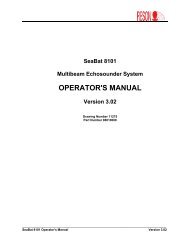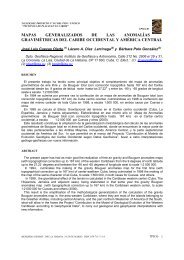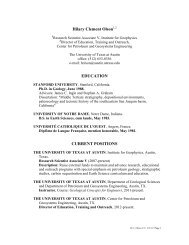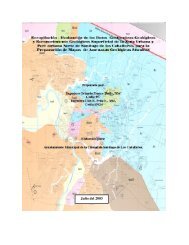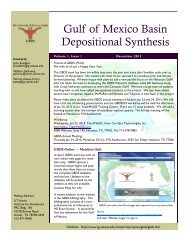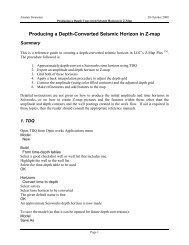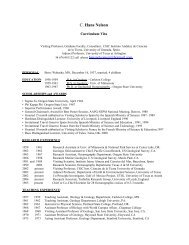The Amazon-HARP Fan Model: Facies Distributions in Mud-Rich ...
The Amazon-HARP Fan Model: Facies Distributions in Mud-Rich ...
The Amazon-HARP Fan Model: Facies Distributions in Mud-Rich ...
Create successful ePaper yourself
Turn your PDF publications into a flip-book with our unique Google optimized e-Paper software.
<strong>The</strong> <strong>Amazon</strong>-<strong>HARP</strong> <strong>Fan</strong> <strong>Model</strong>: <strong>Facies</strong> <strong>Distributions</strong> <strong>in</strong> <strong>Mud</strong>-<strong>Rich</strong> Deep-Sea <strong>Fan</strong>s<br />
Based on Systematic Cor<strong>in</strong>g of Architectural Elements of <strong>Amazon</strong> <strong>Fan</strong><br />
Introduction<br />
John E. Damuth<br />
Department of Geology<br />
University of Texas at Arl<strong>in</strong>gton,<br />
Arl<strong>in</strong>gton, Tx, 75019 USA,<br />
damuth@uta.edu<br />
Although <strong>Amazon</strong> <strong>Fan</strong> is one of the largest deep-sea fans <strong>in</strong> the world, it’s architectural features<br />
are typical of "mud-rich" fans developed on passive marg<strong>in</strong>s, regardless of their size (c.f. Bouma et al.,<br />
1985). Because <strong>Amazon</strong> <strong>Fan</strong> is the only modern fan whose architectural elements have been<br />
systematically drilled and cont<strong>in</strong>uously cored, it is one of the most important modern analogs for<br />
understand<strong>in</strong>g “mud-rich” deep-sea fans and their hydrocarbon reservoir potential. Prior to ODP drill<strong>in</strong>g<br />
<strong>in</strong> 1994, architectural elements and the distribution of sedimentary facies with<strong>in</strong> <strong>Amazon</strong> <strong>Fan</strong> were<br />
<strong>in</strong>ferred from high-resolution seismic, GLORIA side-scan sonar, SeaBeam swath-mapp<strong>in</strong>g and pistoncore<br />
data (Damuth and Kumar 1975; Damuth and Embley 1981; Damuth et al. 1983a, 1983b, 1988;<br />
Damuth and Flood, 1984 and 1985; Manley and Flood 1988; Flood et al. 1991.; Pirmez 1994; Pirmez and<br />
Flood 1995) In particular, these studies revealed that distributary channels have highly meander<strong>in</strong>g<br />
planforms and are perched on natural levee systems. <strong>The</strong> aggradational channel-levee system is thus<br />
recognized as the basic depositional unit of the fan (Fig. 1). High-amplitude reflections (termed HARs)<br />
observed beneath the channel axis were <strong>in</strong>terpreted as coarse-gra<strong>in</strong>ed channel-fill deposits (Fig. 1). More<br />
laterally extensive high-amplitude reflections packets (termed <strong>HARP</strong>s) at the bases of channel-levee<br />
systems were <strong>in</strong>terpreted as coarse sediment deposited either from flows spread<strong>in</strong>g laterally outward from<br />
a channel mouth (i.e. depositional lobe), or from flows issu<strong>in</strong>g through a crevasse <strong>in</strong> a levee dur<strong>in</strong>g<br />
<strong>in</strong>itiation of a channel-avulsion event (i.e. crevasse splays) (Figs. 1, 2). Although only one channel-levee<br />
system was active at any given time, repeated channel avulsion developed groups of overlapp<strong>in</strong>g,<br />
genetically related channel-levee systems, termed channel-levee complexes, across the upper to middle<br />
fan surface. In addition, large, regionally extensive mass-transport deposits overly<strong>in</strong>g portions of<br />
channel-levee systems were recognized on the modern fan surface (Damuth and Embley 1981) and<br />
seismic data showed that older levee complexes buried with<strong>in</strong> the fan are also separated by similar thick,<br />
mass-transport deposits at many locations (Manley and Flood 1988) (Fig. 1).<br />
Results of Drill<strong>in</strong>g dur<strong>in</strong>g ODP Leg 155<br />
ODP Leg 155 cored >4 km of sediment from 17 drill sites on <strong>Amazon</strong> <strong>Fan</strong>. Excellent cont<strong>in</strong>uous<br />
sections were recovered from all major submar<strong>in</strong>e-fan elements <strong>in</strong>clud<strong>in</strong>g: (1 ) levee/overbank deposits<br />
of channel-levee systems of a variety of ages, (2) channel-fill deposits (HAR units), (3) base-of-channel<br />
deposits (<strong>HARP</strong> units), (d) lower fan lobes, and (e) surficial and buried mass-transport deposits.<br />
Terrigenous sediments comprise the vast majority of the cored <strong>in</strong>tervals and display a number of discrete<br />
sandy and muddy facies (Fig. 1) (Normark, Damuth et. al., 1997). Wire-l<strong>in</strong>e logs <strong>in</strong> comb<strong>in</strong>ation with<br />
Formation MicroScanner TM (FMS) images allowed <strong>in</strong>terpretation of ~400 m of coarse-gra<strong>in</strong>ed <strong>in</strong>tervals
of little or no core recovery. (see Flood, Piper, Klaus et al. 1995 and Flood, Piper, Klaus and Peterson<br />
1997 for detailed results of Leg 155 drill<strong>in</strong>g which are briefly summarized here).<br />
<strong>The</strong> levee or overbank deposits are constructed of seven <strong>in</strong>terbedded facies (Fig. 1). Color-banded<br />
mud and clay are most common. Interbeds of coarser sediment are rare to abundant and are<br />
predom<strong>in</strong>antly organized (e.g. x-stratified, graded) and disorganized (structureless) silt lam<strong>in</strong>ae and th<strong>in</strong><br />
beds (100 m), laterally extensive (10’s of km) sand bodies (net:gross = 50-100%) that<br />
were not recognized <strong>in</strong> previous fan models.<br />
<strong>The</strong> thick, regionally extensive mass-transport deposits on the fan surface and buried with<strong>in</strong> the<br />
fan conta<strong>in</strong> ma<strong>in</strong>ly chaotic muddy facies that clearly <strong>in</strong>dicate large-scale sediment failure and masstransport<br />
(e.g. slumps, debris flows) down-fan (Fig. 1). <strong>The</strong>se deposits consist predom<strong>in</strong>antly of thick<br />
<strong>in</strong>tervals (tens of meters) of deformed or chaotic mud with mud clasts and blocks, or discordant,<br />
contorted, folded, faulted, and truncated beds. Thick <strong>in</strong>tervals of disorganized pebbly or gravelly mud and<br />
sandy mud are common, and <strong>in</strong>tervals of homogeneous, structureless mud (possibly undeformed blocks)<br />
also occur. Large scale sediment failures that led to these deposits were apparently <strong>in</strong>itiated at various<br />
locations on the upper and middle fan by processes that are not yet fully understood (Piper et al., 1997)<br />
Dur<strong>in</strong>g periods of glacio-eustatic sea-level lowstand and early rise, <strong>in</strong>dividual channel-levee<br />
systems aggraded at very rapid rates (up to 30m per 1000 yrs), and entire levee complexes of multiple<br />
channel-levee systems formed dur<strong>in</strong>g a s<strong>in</strong>gle 100 ka (4 th order) glacial/<strong>in</strong>terglacial period. Th<strong>in</strong> <strong>in</strong>tervals<br />
of pelagic and/or hemipelagic biogenic muds drape <strong>in</strong>active channel-levee systems and lower-fan areas<br />
away from the active channel-levee system (Fig. 1). Holocene and previous glacio-eustatic sea-level<br />
highstands of the Quaternary have caused the entire <strong>Amazon</strong> <strong>Fan</strong> to become temporarily <strong>in</strong>active for short
periods (~10 k.a.) by forc<strong>in</strong>g the locus of <strong>Amazon</strong> River sedimentation landward to the <strong>in</strong>ner shelf, and<br />
thereby cutt<strong>in</strong>g off the large terrigeneous sediment supply to the fan. As a result, only a th<strong>in</strong> (< 1 m) layer<br />
of calcareous biogenic mud (Fig. 1) has slowly accumulated across the fan entire dur<strong>in</strong>g the Holocene<br />
(Damuth and Kumar, 1975; Damuth et al. 1988). Similar th<strong>in</strong> <strong>in</strong>tervals of biogenic mud recovered deeper<br />
<strong>in</strong> the fan attest to previous periods of fan <strong>in</strong>activity dur<strong>in</strong>g older <strong>in</strong>terglacials (Flood, Piper, Klaus et al.,<br />
1995). <strong>The</strong>se biogenic mud <strong>in</strong>tervals represent condensed sections equivalent to at least portions of<br />
transgressive (TST) and highstand (HST) systems tracts and maximum flood<strong>in</strong>g surfaces (MFS) <strong>in</strong> the<br />
Vail/Exxon conceptual sea-level model.<br />
Conclusions<br />
<strong>The</strong> Leg 155 cores show that despite it's classification as a "mud-rich" submar<strong>in</strong>e fan, many<br />
elements of the <strong>Amazon</strong> <strong>Fan</strong> (HARs, <strong>HARP</strong>s, lower-fan lobes) actually conta<strong>in</strong> very thick sand deposits<br />
(Fig. 1), some of which are laterally extensive and therefore form potentially good reservoir sands (Fig.<br />
2). Stacked, coarse channel-fill deposits (HARs) <strong>in</strong> a channel-levee system can be >10's of meters thick,<br />
up to kilometers wide and extend for 10's of km down fan. Coarse deposits that form <strong>HARP</strong> units<br />
beneath channel-levee systems (Fig. 1) and depositional lobes on the lower fan comprise much more<br />
laterally extensive sand deposits, which can conta<strong>in</strong> stacked sand units 10's to 100's of meters thick and<br />
several 10's of km <strong>in</strong> width and length (Fig. 2). <strong>The</strong> <strong>Amazon</strong> <strong>Fan</strong> demonstrates that some elements of so<br />
called "mud-rich" submar<strong>in</strong>e fans can conta<strong>in</strong> extensive coarse deposits, which should exhibit good<br />
lateral and vertical cont<strong>in</strong>uity and, thus, provide excellent reservoir potential. Such reservoirs would be<br />
enclosed <strong>in</strong> muddy levee/overbank and mass-transport deposits, which should provide good seals. S<strong>in</strong>ce<br />
drill<strong>in</strong>g of <strong>Amazon</strong> <strong>Fan</strong>, many oil companies have utilized 3D seismic data to identify buried meander<strong>in</strong>g<br />
channel-levee systems <strong>in</strong> cont<strong>in</strong>ental marg<strong>in</strong> deposits of the Gulf of Mexico, West Africa, Niger Delta<br />
and other locations, which show architectural elements (HARs, <strong>HARP</strong>s, levees) similar to those of<br />
<strong>Amazon</strong> <strong>Fan</strong> and are now provid<strong>in</strong>g good exploration targets.<br />
References<br />
Damuth, J.E., and Embley, R.W., 1981. Mass-transport processes on the <strong>Amazon</strong> Cone: western<br />
Equatorial Atlantic. Am. Assoc. Petrol. Geol. Bull., 65:629-643.<br />
Damuth, J.E., and Kumar, N., 1975. <strong>Amazon</strong> Cone: morphology, sediments, age, and growth pattern.<br />
Geol. Soc. Am. Bull., 86:863-878.<br />
Damuth, J.E., and Flood, R.D., 1984. Morphology, sedimentation processes, and growth pattern on the<br />
<strong>Amazon</strong> deep-sea fan. Geo-Mar<strong>in</strong>e Letters, 3:109-117.<br />
Damuth, J.E., and Flood, R.D., 1985. <strong>Amazon</strong> fan, Atlantic Ocean. In Bouma, A.H., Normark, W.R., and<br />
Barnes, N.E. (Eds.), Submar<strong>in</strong>e fans and related turbidite systems: New York (Spr<strong>in</strong>ger-Verlag), 97-106.<br />
Damuth, J.E., Flood, R.D., Kowsmann, R.O., Belderson, R.H., and Gor<strong>in</strong>i, M.A., 1988. Anatomy and<br />
growth pattern of <strong>Amazon</strong> deep-sea fan as revealed by long-range side-scan sonar (GLORIA) and highresolution<br />
seismic studies. Am. Assoc. Petrol. Geol. Bull., 72: 885-911.<br />
Damuth, J.E., Kolla, V., Flood, R.D., Kowsmann, R.O., Monteiro, M.C., Gor<strong>in</strong>i, M.A., Palma, J.J.C., and<br />
Belderson, R.H., 1983a. Distributary channel meander<strong>in</strong>g and bifurcation patterns on <strong>Amazon</strong> deep-sea
fan as revealed by long-range side-scan sonar (GLORIA). Geology, 11:94-98.<br />
Damuth, J.E., Kowsmann, R.O., Flood, R.D., Belderson, R.H., and Gor<strong>in</strong>i, M.A., 1983b. Age<br />
relationships of distributary channels on <strong>Amazon</strong> deep-sea fan: implications for fan growth pattern.<br />
Geology, 11:470-473.<br />
Flood, R.D., and Damuth, J.E., 1987. Quantitative characteristics of s<strong>in</strong>uous distributary channels on the<br />
<strong>Amazon</strong> deep-sea fan. Geol. Soc. Am. Bull., 98:728-738.<br />
Flood, R.D., Manley, P.L., Kowsmann, R.O., Appi, C.J., and Pirmez, C., 1991. Seismic facies and late<br />
Quaternary growth of <strong>Amazon</strong> submar<strong>in</strong>e fan. In: Weimer, P., and L<strong>in</strong>k, M.H. (Eds.), Seismic facies and<br />
sedimentary processes of modern and ancient submar<strong>in</strong>e fans: New York (Spr<strong>in</strong>ger-Verlag), 415-433.<br />
Flood, R.D., Piper, D.J.W., Klaus, A., et al., 1995. Proc. ODP, Initial Reports, 155: College Station, TX<br />
(Ocean Drill<strong>in</strong>g Program), 1233 p. (This is the Leg 155 <strong>in</strong>itial reports volumw which conta<strong>in</strong>s core<br />
descriptions and other data collected at each core site)<br />
Flood, R.D., Piper, D.J.W., Klaus, A., and Peterson, L.C. (Eds), 1997, Proc. ODP, Sci. Results, 155:<br />
College Station, TX (Ocean Drill<strong>in</strong>g Program), 695 P (This is the Leg 155 Science Volume which<br />
conta<strong>in</strong>s a number of scientific papers <strong>in</strong>clud<strong>in</strong>g synthesis papers based on Leg 155 drill<strong>in</strong>g)<br />
Manley, P.L., and Flood, R.D., 1988. Cyclic sediment deposition with<strong>in</strong> the <strong>Amazon</strong> deep-sea fan. Am.<br />
Assoc. Petrol. Geol. Bull., 72:912-925.<br />
Normark, W.R., Damuth, J.E., and the Leg 155 Sedimentology Group, 1997, Sedimentary facies and<br />
associated depositional elements of the <strong>Amazon</strong> <strong>Fan</strong>: <strong>in</strong>: Flood, R.D., Piper, D.J.W., Klaus, A., and<br />
Peterson, L.C. (Eds), 1997, Proc. ODP, Sci. Results, 155: College Station, TX (Ocean Drill<strong>in</strong>g Program),<br />
p. 611-651.<br />
Piper, D.J.W., Pirmez, C., Manley, P.L., Long, D., Flood, R.D., Normark, W.R., and Showers, W., 1997,<br />
Mass-transport deposits of the <strong>Amazon</strong> <strong>Fan</strong>: <strong>in</strong>: Flood, R.D., Piper, D.J.W., Klaus, A., and Peterson,<br />
L.C. (Eds), 1997, Proc. ODP, Sci. Results, 155: College Station, TX (Ocean Drill<strong>in</strong>g Program), p. 109-<br />
146.<br />
Pirmez, C., 1994. Growth of a submar<strong>in</strong>e meander<strong>in</strong>g channel-levee system on <strong>Amazon</strong> <strong>Fan</strong>. Ph.D. thesis,<br />
Columbia University, New York, 594 p.<br />
Pirmez, C., and Flood, R.D., 1995, Morphology and Structure of <strong>Amazon</strong> Channel. In: Flood, R.D.,<br />
Piper, D.J.W., Klaus, A., et al., Proc. ODP, Initial Reports, 155: College Station, Tx (Ocean Drill<strong>in</strong>g<br />
Program), p. 23-45.<br />
Pirmez, C., Hiscott, R.N., and Kronen, J.D., 1997, Sandy turbidite successions at the base of channellevee<br />
systems of the <strong>Amazon</strong> <strong>Fan</strong> revealed by FMS logs and cores: Unravel<strong>in</strong>g the facies architecture of<br />
large submar<strong>in</strong>e fans: <strong>in</strong>: Flood, R.D., Piper, D.J.W., Klaus, A., and Peterson, L.C. (Eds), 1997, Proc.<br />
ODP, Sci. Results, 155: College Station, TX (Ocean Drill<strong>in</strong>g Program), p. 7-33.
LEVEES<br />
OVERBANK DEPOSITS<br />
FACIES: Color-Banded <strong>Mud</strong> & Clay;<br />
Regular, Organized Silt and <strong>Mud</strong> Lam<strong>in</strong>ae;<br />
Disorganized, Structurless Silt Lam<strong>in</strong>ae; &<br />
Organized Silt and Sand Lam<strong>in</strong>ae & Th<strong>in</strong><br />
Beds (Graded; Cross-Bedded)<br />
LEVEE<br />
HARs<br />
CHANNEL-FILL DEPOSITS<br />
FACIES: Disorganized Sand Beds<br />
(Structureless to Chaotic); Organized<br />
Sand Beds (Graded & Cross-Stratified);<br />
Chaotic <strong>Mud</strong> and Sand (Mass-Transport)<br />
CHANNEL<br />
PELAGIC/HEMIPELAGIC DRAPE<br />
HIGHSTAND DEPOSITS<br />
FACIES: Calcareous, Biogenic <strong>Mud</strong><br />
LEVEE<br />
<strong>HARP</strong>s<br />
MASS-TRANSPORT DEPOSITS<br />
REGIONAL & LOCAL SLUMPS, SLIDES, DEBRIS FLOWS<br />
FACIES: Disorganized Pebbly or Gravelly <strong>Mud</strong> &<br />
Sandy <strong>Mud</strong>; Chaotic <strong>Mud</strong> w/ Clasts; Deformed/Folded/<br />
Faulted Strata; Structureless <strong>Mud</strong> & Chaotic Sand<br />
<strong>HARP</strong>s<br />
BASE-OF-CHANNEL DEPOSITS<br />
FACIES: Disorganized Sand Beds<br />
(Structureless to Chaotic); Organized<br />
Sand Beds (Graded & Cross-Stratified); &<br />
Disorganized Gravel and Sandy Gravel<br />
Figure 1. Distribution of sedimentary facies with<strong>in</strong> seismic units and architectural elements of a channel-levee system on <strong>Amazon</strong><br />
Deep-Sea <strong>Fan</strong>. <strong>The</strong> schematic diagram shows a typical channel-levee system, which is the basic architectural unit of the upper<br />
and middle fan. Regional mass-transport deposits separate channel-levee complexes <strong>in</strong> many parts of the fan (Modified from<br />
Normark, Damuth et al., 1997).
AMAZON-<strong>HARP</strong><br />
FAN MODEL<br />
CONVENTIONAL<br />
"MUD-RICH"<br />
FAN MODEL<br />
<strong>HARP</strong> UNITS<br />
SAND-RICH<br />
BASE-OF-CHANNEL<br />
DEPOSITS<br />
HAR UNITS<br />
SAND-RICH<br />
CHANNEL-FILL<br />
DEPOSITS<br />
LOBES<br />
SAND-RICH<br />
LOWER-<br />
FAN<br />
DEPOSITS<br />
Figure 2. Left: Schematic diagram show<strong>in</strong>g sand-rich architectural features of "mud-rich" deep-sea fans<br />
based on results of drill<strong>in</strong>g on <strong>Amazon</strong> <strong>Fan</strong>. Right: Previous conventional models for "mud-rich" fans did<br />
not recognize the sand-rich <strong>HARP</strong> units, which <strong>in</strong>dicate that more extensive sand deposits exist <strong>in</strong> these fans.



